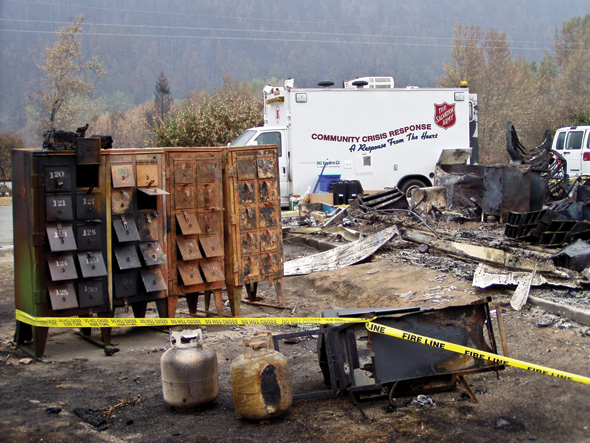 Andrew, his wife and two small children sat in their car waiting for food. Their car was all they had left; their house had been destroyed in a Category 2 hurricane.
Andrew, his wife and two small children sat in their car waiting for food. Their car was all they had left; their house had been destroyed in a Category 2 hurricane.
“As the family was waiting to pick up their food, I asked Andrew how he was doing,” says Captain Glynden Cross, corps officer, North Vancouver. After hurricane Ike struck Texas in 2008, Captain Cross had been temporarily sent to Texas to serve as an emotional and spiritual care specialist. “Andrew just broke down and said, 'I've lost all hope. I don't know what I'm going to do; I can't provide for my family and we've lost everything.'
“I responded, 'You don't have to lose all hope. Take a second and look in your rearview mirror.' He looked at the mirror and saw his two kids in the back seat. I said, 'Doesn't that give you hope to carry on?' He broke down and sobbed, and I prayed that God would comfort the family and help them through this challenging time.”
Andrew and his family were not the only ones grappling with the realities of life. The hurricane also affected Cuba, Haiti and the Bahamas in the Caribbean, and Louisiana, Mississippi and Alabama in the United States. It resulted in more than 100 deaths and an estimated $24.9 billion worth of damage—the third costliest hurricane for the United States.
Captain Cross spent two weeks in Galveston, Texas, and over that time witnessed Andrew's hope increase and saw his life get back on track.
“You are able to see the difference that is made in people's lives by coming to The Salvation Army and getting not just the food and physical support, but also the emotional support,” Captain Cross explains. “When we pray with people, we must be non-judgmental and sensitive. We have to wait to be invited in, but once we're invited, God brings so many blessings. I consider myself privileged to be able to bless others and be part of this ministry. In a heartbeat, I'd go back and do it all over. It blesses me beyond measure; I want to do whatever it takes for me to be effective in this ministry.”
History of Action
Emergency disaster services ministry has been an important aspect of The Salvation Army in Canada and Bermuda since December 1917 when two ships—Imo and explosive-laden Mont-Blanc—collided in the Halifax Harbour. An immediate fire resulted, drawing emergency crew and spectators. To avoid German attack, the Mont-Blanc flew no warning flag regarding its cargo and so no one was aware that 20 minutes later, the biggest man-made explosion in history would occur. With 2,000 deaths and 9,000 injuries as a result of the collision, two Salvation Army officers were mobilized into action.
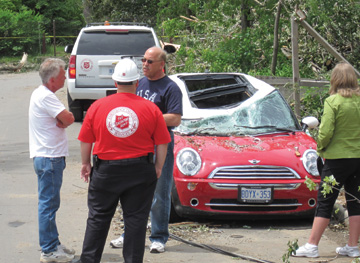
“Those two officers didn't stop to think, they just started helping,” says Major Rick Shirran, territorial emergency disaster services director. “The Salvation Army has a desire to help people; it is just a natural thing. And that's what we still do today. We help, we don't hesitate.”
The 900 emergency disaster services personnel—officers, employees and volunteers—in the Canada and Bermuda Territory are dedicated to providing food, beverages and shelter in times of need. Across the territory, there are more than 40 mobile canteens known as community response units that can provide anything from hydration and snacks to hundreds of hot meals.
Meet and Greet
“We also offer 'meet and greet,' ” explains Major Shirran. “This is a ministry that happens in an emergency shelter when people first enter; one of our personnel is there to meet, greet and direct people to the help that they need. This service is used not only in disasters, but also at government health agencies such as immunization clinics for the H1N1 vaccination in 2009.”
Major Shirran also believes The Salvation Army is in a privileged place to offer the “ministry of presence” through emotional and spiritual support. “We sit on the curb with people,” he says. “We cry with them, listen to them and perhaps help them to think through something rationally at a time of their life when there's so much turmoil. Through this ministry, we are able to be the hands, feet and voice of Christ to people affected by traumatic experiences.”
Beyond the Border
Our territory does not respond to disasters in isolation but partners with other organizations, such as the Red Cross or St. John's Ambulance and the four Army territories in the United States. By doing so, the Army is positioned to offer an effective response on all levels in emergencies and disasters. Working with the U.S. in particular involves offering assistance during disasters, such as hurricanes Ike, Katrina and Gustav, collaborating on training curriculum, sharing volunteer databases and practising responses together.
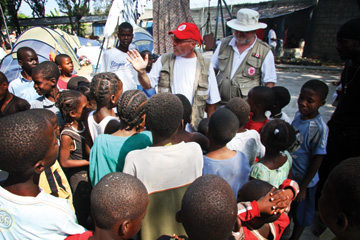
We are also linked to the international Salvation Army through SATERN (Salvation Army Team Emergency Radio Network). The 140 members in Canada—and 4,000 worldwide—receive health and welfare requests in times of disaster via its website (satern.org), and personnel respond by searching for and connecting people. SATERN can also provide the Army with radio and data communications during disasters.
Two large emergencies that Major Shirran assisted with were the New York terrorist attacks on September 11, 2001, and the Haiti earthquake on January 12, 2010. Responding to these two events had a powerful effect on him, and demonstrated the importance of the emergency disaster services ministry.
“I was Red Zone co-ordinator for The Salvation Army's response in New York,” says Major Shirran. “I did a 12-hour shift every day for two weeks. Some people had been there for many days, digging through the rubble in the pit at Ground Zero. People were broken and emotionally drained by all that was going on. To see the ministry we could have to those people made a real impression on my life.
“When I came back from Haiti, my outlook on a lot of things changed,” says Major Shirran. “The way I look at food, for example. The Haitians are trying to gather a little bit to get them through the day, yet we have so much food that we throw it out,” he says. “Being there and seeing the Haitians struggling to get the basics of life from moment to moment, and seeing that we have so much here that we take for granted, it amazed me.”
Responding to a Disaster
Every event The Salvation Army responds to follows a unique timeline as each response is tailored to the specific emergency situation. The following is one example of how the Army's emergency disaster services may respond to a fire in an apartment building. This particular example differs greatly to the response that would be made to a local flooding, hurricane or search-and-rescue operation.
A fire starts in an apartment building at 4 a.m. and the fire department responds immediately. Occupants are evacuated to a reception centre.
• The municipality contacts a Salvation Army 24-hour dispatch facility. The on-call person obtains information regarding the event, its location, what is requested, how many people will be needed and who to contact for more details.
• The on-call person from the dispatch facility phones the appropriate Salvation Army contact to assist.
• The emergency disaster services personnel member co-ordinates their team. In the case of a short-term evacuation to a reception centre, only two team members are required. Should the evacuation be longer than anticipated, a second team will be called in.
• The team members arrive within one hour of the phone call and immediately serve basic refreshments such as water, hot beverages and snacks.
• Team members also inform evacuees about other Salvation Army facilities, such as the thrift store and family services, should they be needed at a later stage.
After a few hours evacuees are transported to a hotel and The Salvation Army's emergency response ends.
Case Study: Flooding in British Columbia
The British Columbia Division is well-equipped with 13 mobile crisis response units (plus three support vehicles) and 600 Salvation Army trained personnel.
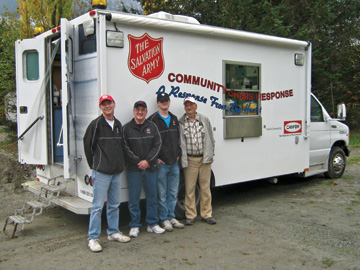
“A lot of the personnel have critical incident stress management training,” says Captain Glynden Cross, corps officer, North Vancouver. “Many hikers go missing in the nearby mountains and I've been involved in several search-and-rescue responses as part of emergency disaster services. We provide meals and emotional and spiritual care to the search-and-rescue teams who sometimes find a deceased person.”
On other occasions, searches are called off because the missing person cannot be found. “A search for an elderly woman was called off, and one of the search-and-rescue team members was the same age as her son,” says Captain Cross. “He looked at me and cried. I could see the sense of failure and loss in his face. We talked about it and walked through what had been done, and that helps with the healing process. It is a privilege to reassure the search-and-rescue individuals that what they do is important.”
Toward the end of last year, while the Bermuda and Newfoundland and Labrador Divisions were battling hurricane Igor, the British Columbia Division was putting its training into practice due to major rainfall and flooding in Bella Coola, B.C. Roads were washed out, leading to an isolated population, depleted stock and low morale in the community.
The division has a strong relationship with the Provincial Emergency Program, and a few weeks after the rain stopped, the Army was asked to help with recovery. John McEwan, divisional emergency disaster services director, asked Captain Cross to step in as incident commander.
Captain Cross co-ordinated two response teams over two weeks from Williams Lake and Quesnel. The teams served food from the Prince George mobile unit, distributed meals to homes and offered emotional and spiritual care to the population affected by the flooding.
“The team members shared stories with me of how they helped those in need,” says Captain Cross. “They were hugged and many people cried as they expressed their thanks.”




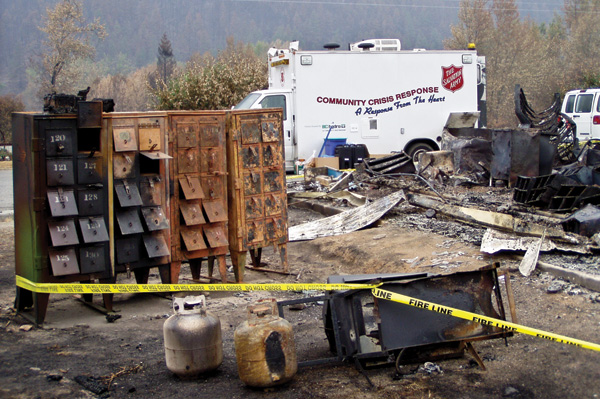
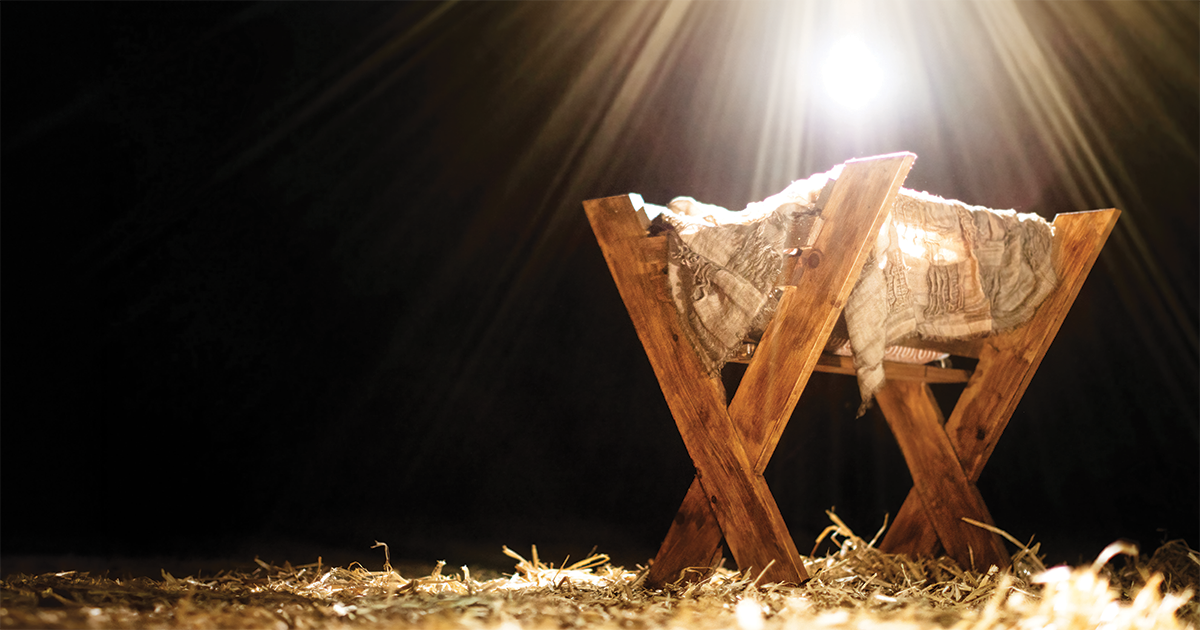
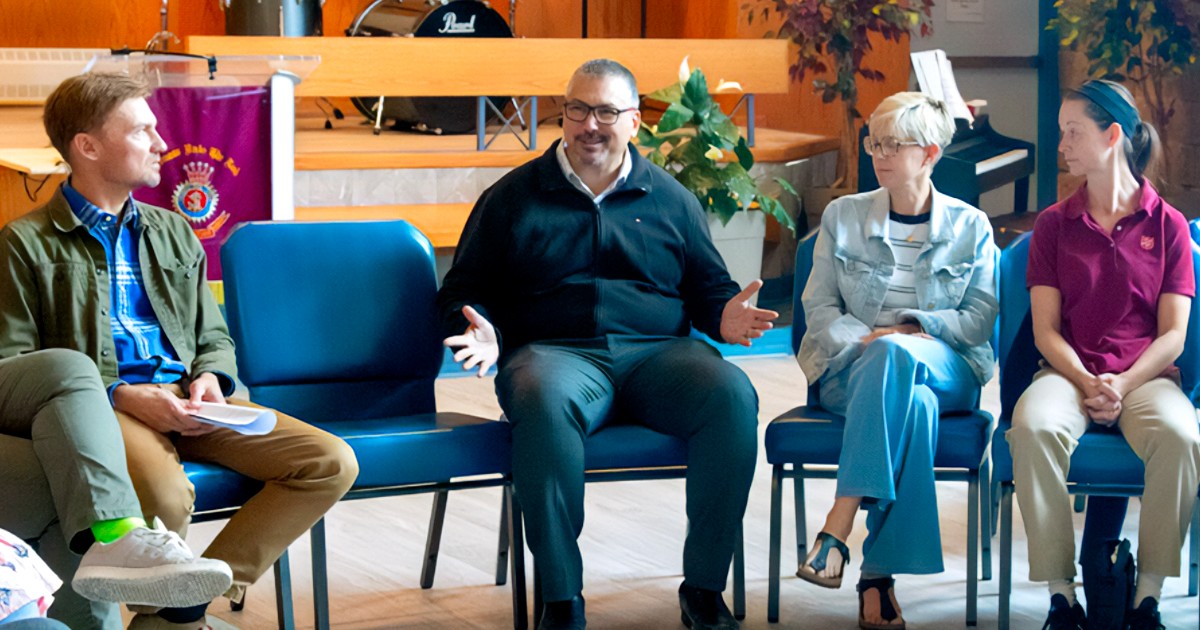
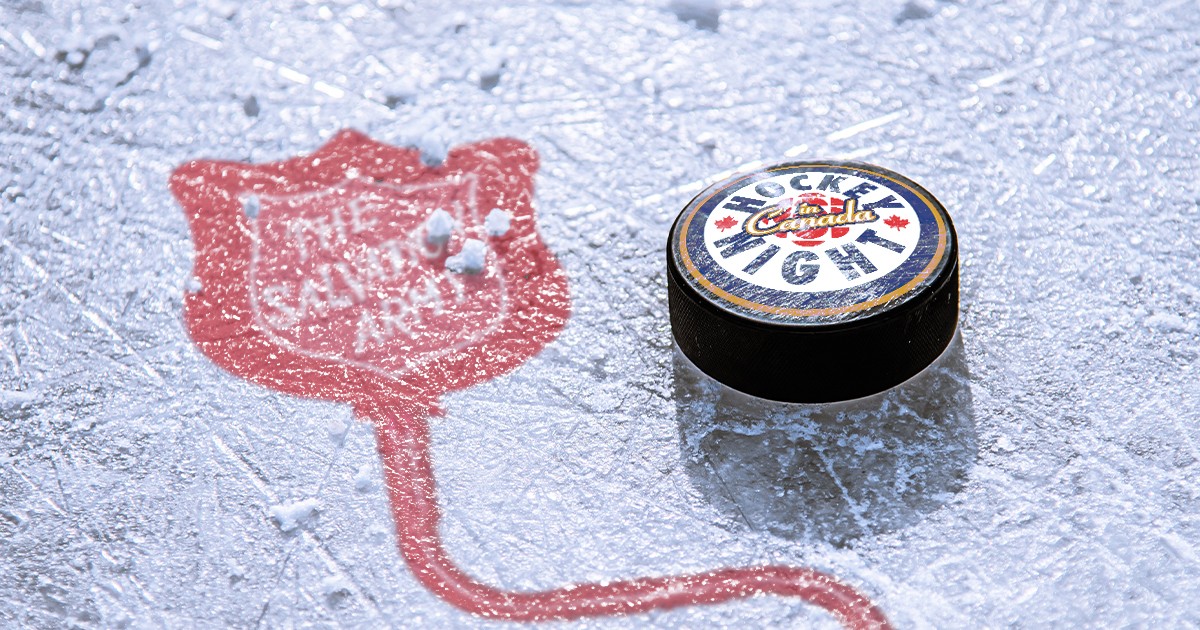


Leave a Comment